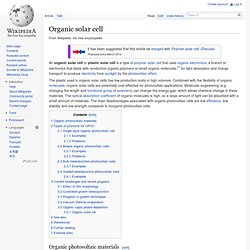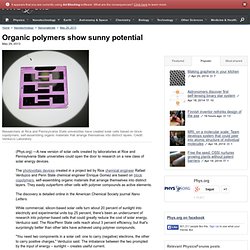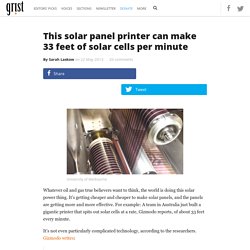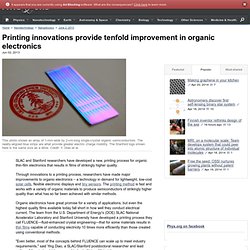

Organic solar cell. An organic solar cell or plastic solar cell is a type of polymer solar cell that uses organic electronics, a branch of electronics that deals with conductive organic polymers or small organic molecules,[1] for light absorption and charge transport to produce electricity from sunlight by the photovoltaic effect.

The plastic used in organic solar cells has low production costs in high volumes. Combined with the flexibility of organic molecules, organic solar cells are potentially cost-effective for photovoltaic applications. Molecular engineering (e.g. changing the length and functional group of polymers) can change the energy gap, which allows chemical change in these materials.
Unlocking nature's quantum engineering for efficient solar energy. (Phys.org)—Quantum scale photosynthesis in biological systems which inhabit extreme environments could hold key to new designs for solar energy and nanoscale devices.

Certain biological systems living in low light environments have unique protein structures for photosynthesis that use quantum dynamics to convert 100% of absorbed light into electrical charge, displaying astonishing efficiency that could lead to new understanding of renewable solar energy, suggests research published today in the journal Nature Physics. The research resolves an important mystery in the newly-emerging field of quantum biology – the origins and longevity of the quantum, wave-like properties that transport energy during the early stages of photosynthesis, phenomena unexpectedly observed in molecular complexes extracted from a variety of plants, algae and bacteria. Unlocking nature's quantum engineering for efficient solar energy. Green sulfur bacteria. Green sulfur bacteria are nonmotile (except Chloroherpeton thalassium, which may glide)[1] and occur in spheres, rods, and spirals.

[citation needed] Photosynthesis is achieved using bacteriochlorophyll (BChl) c, d, or e, in addition to BChl a and chlorophyll a,[1] in chlorosomes attached to the membrane. [citation needed] They use sulfide ions, hydrogen or ferrous iron as an electron donor and the process is mediated by the type I reaction centre and Fenna-Matthews-Olson complex. Elemental sulfur deposited outside the cell may be further oxidized. By contrast, the photosynthesis in plants uses water as the electron donor and produces oxygen.[1] Chlorobium tepidum has emerged as a model organism for the group; although only 10 genomes have been sequenced, these are quite comprehensive of the family's biodiversity.
Organic polymers show sunny potential. (Phys.org) —A new version of solar cells created by laboratories at Rice and Pennsylvania State universities could open the door to research on a new class of solar energy devices.

The photovoltaic devices created in a project led by Rice chemical engineer Rafael Verduzco and Penn State chemical engineer Enrique Gomez are based on block copolymers, self-assembling organic materials that arrange themselves into distinct layers. They easily outperform other cells with polymer compounds as active elements. The discovery is detailed online in the American Chemical Society journal Nano Letters. This solar panel printer can make 33 feet of solar cells per minute. Whatever oil and gas true believers want to think, the world is doing this solar power thing.

It’s getting cheaper and cheaper to make solar panels, and the panels are getting more and more effective. For example: A team in Australia just built a gigantic printer that spits out solar cells at a rate, Gizmodo reports, of about 33 feet every minute. It’s not even particularly complicated technology, according to the researchers. Printing innovations provide tenfold improvement in organic electronics. SLAC and Stanford researchers have developed a new, printing process for organic thin-film electronics that results in films of strikingly higher quality.

Through innovations to a printing process, researchers have made major improvements to organic electronics – a technology in demand for lightweight, low-cost solar cells, flexible electronic displays and tiny sensors. The printing method is fast and works with a variety of organic materials to produce semiconductors of strikingly higher quality than what has so far been achieved with similar methods. Organic electronics have great promise for a variety of applications, but even the highest quality films available today fall short in how well they conduct electrical current. The team from the U.S. "Even better, most of the concepts behind FLUENCE can scale up to meet industry requirements," said Ying Diao, a SLAC/Stanford postdoctoral researcher and lead author of the study, which appeared today in Nature Materials.
New additive offers near-perfect results as nucleating agent for organic semiconductors. (Phys.org) —Pixie dust may be the stuff of fanciful fiction, but for scientists at UC Santa Barbara's Department of Materials, a commonly used sugar-based additive has been found to have properties that are near magical.
By adding minute amounts of it during the fabrication of organic semiconductors, they have been able to dramatically increase yield and control crystallization, which could, in the near future, make the technology not only cheaper and more accessible, but also enhance its performance. Results of their study are published in the recent issue of the journal Nature Materials.
"We have developed a new method to utilize low-cost, environmentally friendly materials from the commodity chemical industry to control the performance of organic semiconductors," said Michael Chabinyc, associate professor of materials. "The electrical properties of organic semiconductors depend critically on the way in which molecules pack together—the crystallinity. Solar cell fabrication is simplified by spray painting - News releases - News.